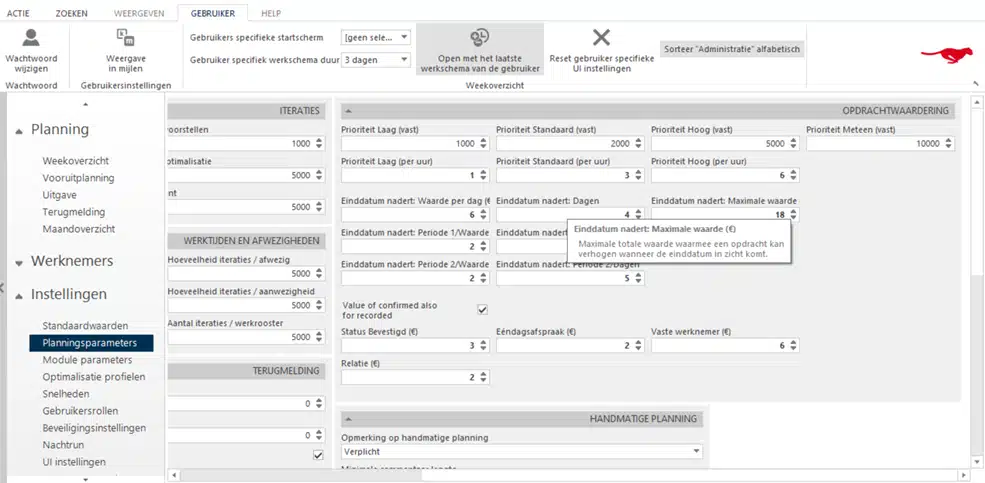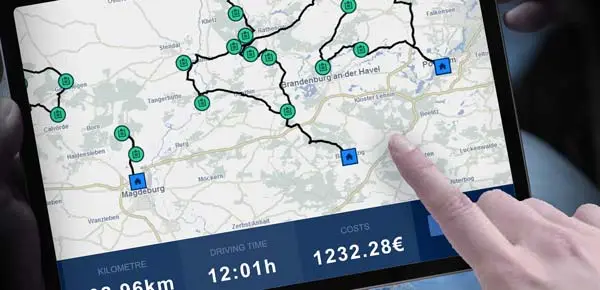
BLOG / RESEARCH · FIELD OPERATIONS MANAGEMENT USE CASE
UTILITIES: HOW TO MASTER QUALITY IN FIELD OPERATIONS MANAGEMENT
02 October 2024 · James Alex Waldron
Field operations management is used by Netze BW across their gas and electricity network. The organisation is divided into 5 regions with 5 order centres. Here, a total of around 600 field technicians serve an area of around 20,000 square kilometres.
The field workforce management system architecture at Netze BW is based on existing SAP back office systems. FLS VISITOUR is connected as a dynamic dispatching tool. A proprietary mobile app ensures the connection with technicians in the field.
DYNAMIC, HIGHLY OPERATIONAL IT FOR THE UTILITY SECTOR
In a best practice presentation titled 'Bringing Smart IT to Life', Ernst Vötsch, Data and Applications at Netze BW, shared his insights following 10 years of Field Operations management using FLS VISITOUR.In this research write-up, with over a decade of FLS VISITOUR experience, he explains the relationship's starting points and the challenges of designing field workforce management processes within complex utility companies. He addresses the aspects of measuring and mastering quality, and learning the characteristics of good deployment control within SAP. He also shares his recommendations for action.
"The serious upheavals in the energy industry had a profound impact on the working environment at Netze BW. For example, changes in the organisation of the network operation from around 100 small, historic five-man 'craft businesses' to today's industrial standard factories led to a fundamental shift.
We continue to be confronted with major operational challenges at various levels, which continue to strongly influence our actions and our approach to this day."
Ernst Vötsche · Data and Applications, Netze BW- Strict planning and comprehensive transparency, from a 'call-out' culture and 'just do it'.
- Extensive standardisation of activities and processes. Comprehensive reorganisation with concentration, consolidation and reorganisation of tasks and role authorisations.
- Introduction of field operations software, with mobile connection and centralised dispatching tools.
VOLUME, DIVERSITY AND FIELD SERVICE COMPLEXITY
At the planning level, the diversity of everyday planning moving on from a small-scale nature of orders and the new, different approaches and processes resulted in the highest demands.The many deployment requirements for the utility company cover an entire spectrum of planning characteristics; from 'fire brigade' deployment to planned servicing, reactive customer visits, and major projects.
Large numbers of operations (average duration approx. 60 - 90 minutes) and complex constructions (using multiple employees and skills) made it fundamentally difficult for all those involved to gain an overview of the operational process. Historically determined and highly individualised/different approaches and expectations harboured the potential for conflict and created an immediate need for harmonisation. This made operational planning - whether with or without a tool - an 'experience'! You need a good plan to plan well!
SOLVING 'PEOPLE VERSUS MACHINES'
At the system level, the challenge then was to provide a suitable dispatching tool and a stable, nationwide mobile connection:- The available tools are - as of 2009 - relatively new and are constantly evolving
- The same applies to many manufacturers
- Mobile network coverage is often not available nationwide
- Mobile devices are expensive, error-prone and not yet particularly powerful
- Users/customers often have unrealistic expectations and create (too) complex and difficult requirements
All of these challenges added up to a complex situation. In times of general upheaval and change, employees are generally unsettled and we faced 'everything was better in the past anyway'. The new requirements placed on the users during deployment planning are demanding and initial technical problems and learning new functions fuel reservations and resistance to new technologies.
Dynamic field operations management was therefore viewed critically, because ACCEPTANCE can only be achieved if the system and the planning results generated 'feel right'. The discussions for and against were often very much reduced to IT level. Early day technical errors are very strongly emphasised / brought to the fore. From the very beginning, quality criteria and features were therefore central to our focus! Very low error tolerance on the part of the user creates great pressure to provide functioning technology and to produce understandable, reasonable planning results.
We therefore paid close attention to the quality and functionality of FLS VISITOUR from the very beginning. In the following, we will look at what 'correct' means in the context of planning results, or what actually characterises mastering field operations.
"Above all, we had to deal with fundamental planning contexts much more intensively than originally expected: The hope/expectation that 'the system will just do it…' is deceptive, because 'you need a good plan to be able to plan well', and we weren't always smart in this regard at the beginning."
Ernst Vötsche · Data and Applications, Netze BWQUALITY IN FIELD OPERATIONS MANAGEMENT
Quality operational management is the product or result of good work preparation, good deployment planning and the most precise possible implementation of these. If you become more precise and look more closely, a series of further questions arise step by step. In relation to the process step of planning deployments, the first thing to clarify is:
1. What does 'good' mean in the context of operations planning?
Good or optimal planning can be said to be carried out when the planning results reflect, as far as possible, the general operational planning objectives that are to be defined in advance. The three main objectives from Netze BW's perspective are:
- Shortest possible route or short travel times
- Order deadlines are met
- Best possible technician utilisation
These goals compete with each other and must be prioritised against each other. A fundamental decision must be made because the parameterisation of FLS VISITOUR is essentially derived from this.
A possible prioritisation would be, for example:
- Order deadlines are met
- Best possible technician utilisation (e.g. around 100%)
- Shortest possible route or short travel times
Important: All other expectations, specifications and premises that must be implemented as part of the operational planning, such as:
- Regulations and laws, such as framework working hours
- Skills/qualifications, training, etc.
- Availability of work tools, parts, etc.
...rank ahead of the planning goals and further limit the attainability of these. This not only has consequences for operational planning, but also offers a great deal of scope for assessing and perceiving the quality of these!

What is important and aligned to your unique operations? FLS VISITOUR can take into account more than 100 different parameters.
2. How are the planning results evaluated?
Planning results and routes are perceived subjectively by the individual participants. Different criteria are quickly used for the evaluation and individual expectations and priorities play a role! This subjective component in the perception of a plan should not be underestimated and it is of course very problematic in terms of an objective discussion and assessment of the quality of planning results if mainly individually prioritised criteria and subjective expectations are used as a benchmark! The question is therefore:
3. Is there an objective, irrefutably best option for operation planning, or how can you find and recognise it?
A look at the mathematics shows us that common planning factors very quickly lead - purely mathematically - to unimaginably large sets of solutions.
For example: A vehicle is to visit 10 customers in one day. There are =10! = 10*9*8*7*6*5*4*3*2*1 = 3.6 million possibilities. If several vehicles are to be planned at the same time, e.g. 85 customers and 10 mechanics/vehicles, there are already 10^85 possibilities! A 10 with 85 zeros!
Such tasks can no longer be calculated in a closed form! The PowerOpt Algorithm developed for this purpose help to find good solutions in a reasonable amount of time, but: The one, objectively irrefutable best solution will generally not be known in such planning scenarios - which generally exclude trivial, obvious optimal solutions!
If - as is the case with Netze BW - there are no or insufficient objective indicators/key figures available for the clear assessment/measurement of the quality of a plan in a very demanding, complex planning environment, there is hardly any possibility of determining this quality quickly and objectively.
This means that individual planning results can be questioned! It is therefore very important to make key figures and metrics available that are as meaningful as possible and to continuously expand and refine these systems.
4. What elements affect the planning of field operations?
However, planning results can also be rightly called into question. Even in the planning process, there are plenty of sources of error and disruption that lead to (more or less) obviously suboptimal results in operational planning. We learned the following success factors, among others, have a direct impact on the quality of planning:
- Framework and organisation
- Conceptual weaknesses
- Planning concepts
- Goal and role conflicts
- System structure
- Dispatching tool (parameters and functions)
- System usage
- Understanding and approaches
- Goal, role and process loyalty
As an example, the topics of system structure and system usage are examined in more detail here:
Focus: System structure Dispatching Tool
A dispatching tool must have the necessary functions. All data must be correctly maintained (e.g. working hours, addresses, geo-data, skills, etc.). Parameterization/settings must be made in accordance with the planning objectives, e.g. weighting of deadlines, kilometers driven and working hours, use of priorities, etc. Depending on the number of setting options, it can quickly become very complex.
Focus: System Usage
The prerequisites for the creation of good and efficient planning are: Work planners/dispatchers must be very familiar with how to operate the systems. The tool functions and the functionality of the planning automation must be understood. The dispatcher must have a strong planning mindset and goal-oriented methodology and understand the planning context (e.g.: use degrees of freedom). The dispatcher's willingness to plan must go so far that not only does every technician have enough to do, but that the planned assignments are also combined into the most efficient routes possible. The key: Human and machine must therefore work together as well as possible - i.e. 'smartly' - and be coordinated with one another.
5. What elements affect the implementation of the plan?
Good operational planning is no guarantee for a good end result. Even in the implementation of the planning result, i.e. the execution of the operations, there are elements that can have a negative impact on the implementation of 'good' planning.
The following factors, among others, have a direct impact on the quality of implementation:
External influences:
- Disturbances at the planning level (unplanned disruption)
- Disturbances to the process from outside
Internal influences:
- Faulty/inadequate AV or planning
- Lack of implementation fidelity
Here, too, we take a closer look at examples of external disruptions to the process and a lack of implementation fidelity:
Focus: Disturbances to the process - from outside
- Customer not found
- Unplanned setup trip necessary, e.g. materials missing
- Atmospheric influence (rain, fog, darkness)
- Timing deviates (plan-actual deviation of deployment duration)
This is where escalation management is needed. Close communication between technicians and dispatchers is necessary. Lesson learned: It is definitely helpful to define behaviours for each scenario in advance. In addition, these 'disturbances' or their causes - as far as they can be influenced - must be remedied at organisation level.
Focus: Lack of 'implementation fidelity'
An example of this is: Technicians deviate from the schedule during processing without there being any external disturbance.
Reasons for this may be:
- Roles and competencies are not clearly defined and demarcated
- Roles and competencies are not understood and/or accepted
The aim here is to promote understanding and acceptance among the technicians. Learning: Clear rules and guidelines are helpful and sustainable communication is essential.

QUALITY MEASURES TO TAKE INTO YOUR PROJECT
The following measures minimise the influence of disturbances and support sustainable quality management at Netze BW:
- Develop planning concepts (case-related) and demonstrate planning contexts and promote planning understanding among those involved
- Change management to introduce and maintain WFM-compliant behavior and working practices
- Training courses tailored to needs and users (content and methods)
- Key performance indicator system to make planning quality, implementation quality, etc. visible/measurable
- Organisational measures (e.g. clearly defining processes, defining roles, agreeing on binding SLAs, etc.)
- Constant expectation management and leadership

CONCLUSION
In order to achieve high-quality operational control and optimal results, it is necessary to know the disruptive factors that affect the planning and implementation processes and to eliminate them as far as possible in advance. If FLS VISITOUR is parameterised in a targeted manner and its functionality is used in a targeted manner, this is the guarantee of achieving good results in deployment planning and therefore a good overall result!People are proving to be the key success factor. To ensure that they do not become a disruptive factor, they must be 'picked up' and 'taken on your journey'. Smart people on smart machines ensure that smart service automation, i.e. value creation in the smart interaction of people and machines, is possible in the first place.
LONG-LASTING FIELD OPERATIONS TRANSFORMATION
We evaluate your field organisation's process efficiency, planning quality, and cost structure. To gain an understanding of tools to optimise field service and solve optmisation pressures book a short discussion or contact us at info@fastleansmart.com.Further reading:
E.ON switches to FLS Field Force Scheduling solution for UK operations
Optimised Field Service Management: Top 10 blog articles 2023
CONNECTED MINDS 2023: FLS and mobileX joint event celebrates successful premiere
Read more research:
Trend Report: Top 10 Challenges In Field Resource Optimisation
Trend Report: Field Service Recruitment and Retention

JAMES ALEX WALDRON
UK Marketing Manager
+44 1183 800189
Send email
James Alex Waldron has worked in written communications for over 15 years. Since 2021, he has written for FLS and the Solvares Group on the topics of digital field service transformation and mobile workforce management, and regularly provides insight to the industry press.





